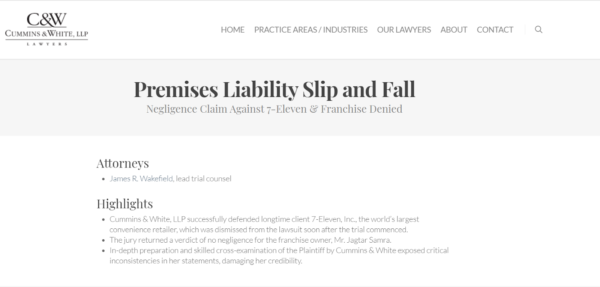
When marketing your law firm, writing a top-notch legal case study is one of the best ways to attract new clients. Successful law firm case studies can highlight your attorneys, your firm’s success, and your trustworthiness as a business, all of which will earn you new clients! Writing a legal case study is time-consuming work, but the result is well worth the effort.
If you’re new to creating legal case studies, learn below how writing a case study builds client trust, as well as tips for writing a compelling case study, including:
- Getting permission from your client
- Choosing the right case
- Making your case study easy to read
- Providing easy access to your case study
- Telling a compelling story
Get new clients and drive referrals with marketing tools and advice for legal professionals.
How case studies build client trust
Essentially, a case study is a well-written explanation of how a specific client won their case with the help of a particular law firm. Every case study should touch on how the legal issue arose, what steps the law firm took to assist the client, and how the case was resolved successfully.
When you take the time to write a law firm case study, you are providing prospective clients with:
- Proof of your firm’s authority
- Examples of your firm’s previous success
- A compelling reason to hire your law firm for their case
Ultimately, case studies offer prospective customers definitive proof of your law firm’s reliability in the understandable format of a story. You can highlight case studies on your law firm’s website and as a part of your firm’s social media marketing strategy.
5 tips for writing an effective legal case study
There are several different tactics for writing a case study to be a part of your legal services marketing strategy. The tips below can help guide you in the right direction.
Getting permission from your client
As a part of the legal services industry, you know that legal matters are often rooted in personal situations.
Whether there is sensitive information involved or not, you must acquire your client’s written consent before writing your case study. You should plan on connecting with your client throughout the writing process. This will deepen your relationship with the client and demonstrate that your law firm values trust, client connections, and transparency.
Building this relationship raises the chances of your client leaving a positive review on one of your law firm’s online listings.
Beyond this, always double-check that the information you include follows all court orders, client agreements, releases, and other legal documentation before you start writing.
Choosing the right case
When choosing the right case for your study, consider your goal to demonstrate your skills as a law firm to prospective clients. To do this, it helps to start with identifying your ideal client. From there, consider cases that would align most with your ideal client base.
Think about elements like:
- Common problems your average client faces
- The type of client and cases you are seeking for the future of your firm
- What elements of the case study your prospective clients might relate to
In the example below, Cummins & White, LLP offers its clients an easy-to-read portfolio of cases.

The grid format is effective because it allows the clients to read about the case that appeals to them or that they relate to the most. Notice how the particular page above makes the information easy to parse. When building your law firm website, consider using a website building tool to achieve superior organization.
Making your case study easy to read
Beyond website organization, the actual content of your case study must be distilled into easy-to-read language and formatting.
When writing, follow best practices such as:
- Keep things short. Eliminate all fluff and shorten long-winded sentences.
- Get to the point. Use brief sentences and short paragraphs that speak directly to the important details of your case.
- Simplify your language. Legalese can be confusing for the lay reader. Distill the content of your case into language that is simple and clear.
Consider the example below by Cummins & White, LLP. Before the case study opens into prose, this law firm distills the case into simple bullet points. This provides readers with a quick version of the case study that introduces their success and their attorneys to prospective clients.

In the opening paragraph of the case study, the entire case is outlined to the reader. Notice there is absolutely no flowery language or artistic additions. It is straightforward and clear — just as all case studies should be! While the rest of the case study dives into more detail, the straightforward language remains consistent throughout.

Providing easy access to your case study
Once you’ve written a stellar case study, you must make it easy for your clients to find.
To earn more leads, post your case study in places like:
- Your website. If the goal is to drive clients to your mobile-responsive website, posting case studies can help by elevating your SEO and drawing more clients to your content.
- Your social media channels. Case studies can be integrated into your content marketing on both your website and social media channels. Use social media to highlight exciting case studies and drive traffic to your website.
- Your email newsletter. Highlighting your latest case study is a great idea for your next legal services email campaign. Creating buzz around the case study will drive more prospective clients to your site and into the hiring process.
Cummins & White makes it easy for potential clients to access case studies directly from their landing page, as you’ll see in the example below.

Telling a compelling story
What do you love about reading content of any kind? Chances are that the blogs, books, and articles that you love all have one thing in common — they tell a compelling story.
To utilize storytelling techniques within your legal case study, make sure to:
- Introduce the important parties in your case
- Follow a narrative arc — with rising action, pinnacle of action, and resolution — whenever possible
- Use easy-to-follow language and plot points, no matter how complex the issue
If you can hook readers into your case study with an intriguing story, you are more likely to maintain their interest and, ultimately, gain a new client. Remember, you are telling a true and human story about your client. Treat their story with care and respect, and your case study will shine as a result.
Do more to improve your law firm’s online marketing
Now that you understand how law firm case studies can build trust with clients and have learned some important tips for writing an exceptional one, are you ready to get started?
Writing a great law firm case study is just one element of online marketing. If you want to read more marketing advice for legal professionals, check out The Download — a free marketing guide for professional service providers.




